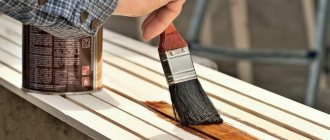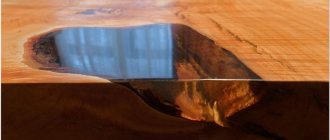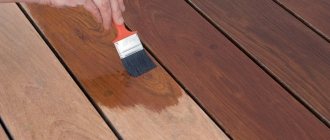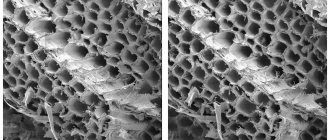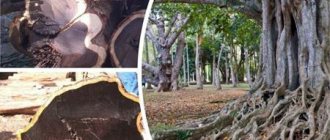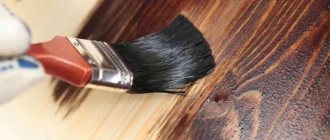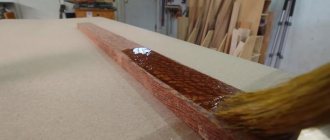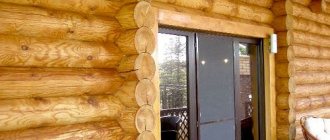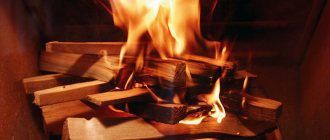Harm from humidity and microorganisms
Regardless of the construction in which lumber is used, it is still exposed to precipitation or moisture vapor inside rooms. Precipitation is understandable; it penetrates into the fibrous structure of the wood, reducing the strength of the material. Under favorable temperature conditions, fungi and mold begin to appear inside damp wood, for which the humid environment is their home.
Boards, beams, logs begin to darken and rot, which ultimately reduces their strength and leads to destruction.
As for humidity inside the house, it is good if wooden wall decoration is used in dry rooms. Here it will last longer, but you must also take into account the fact that wood is a material that burns well. Therefore, we need to think about the question of how to reduce the fire hazard of a building. Thus, it is best to choose a composition for impregnating wood that will protect not only from moisture and rot, but also from fire.
Security measures
When working, it is important to protect the skin from contact with the impregnation. Therefore, protective clothing and gloves are worn. You also need to avoid getting the product into your eyes. If contact with a person occurs, the area is washed with water.
It is allowed to dispose of the remaining Senezh impregnation as a regular household composition. The products are not fire or explosive.
When working, it is important to protect the skin from contact with the impregnation.
Folk remedies
There are a lot of folk tips and recipes (inexpensive and effective) for treating walls, ceilings and other structures against rotting. Some impregnation compositions are very easy to use and inexpensive.
- The protection method is based on the use of vegetable oil and propolis, which are mixed in a 3:1 ratio. The resulting solution is applied to wood, previously cleaned of dirt and dust. The method is simple and effective if the task is to neutralize harmful microorganisms. But such impregnation is not fire-resistant. On the contrary, it supports combustion well.
- Copper sulfate. This is a blue granule powder that must be diluted with water. The solution (one percent) is applied to the cleaned surface with a brush, sponge or sprayer. This impregnation is very effective, since copper sulfate kills all bacteria and fungi and penetrates deep into the structure of the wood. The only negative is that the solution takes a long time to dry (10-20 days depending on the temperature).
- Previously, tar was used to coat the lower crowns of log houses. Later they began to use hot bitumen. A good impregnation option in terms of efficiency, but as far as safety and environmental friendliness are concerned, there are many questions here.
- Machine oil. At one time, wood processing was used very often, and this helped in the fight against almost all negative factors related to the protection of lumber from rotting. But the oil burns well, which has caused more than one fire. So it was subsequently abandoned, although this folk method is still used.
- Finnish method. The technology got its name from the name of the country, because this method is still used in Finland. It is based on a mixture of several ingredients: copper sulfate, slaked lime, salt and flour. All components are mixed in certain proportions and diluted with water to a paste. The treatment is carried out in two layers, the second is applied to the first after it has completely dried. The paste impregnation method is harmless and effective. Today it is used mainly for processing wooden fences and roofs, because the paste is practically not washed out with water.
There is also a method that does not involve impregnation and consists in firing boards or logs of wood. Lightly moistened wood is burned with a blowtorch, which kills all harmful organisms and creates protection from moisture and rot. That part of the fence posts that will be in the ground is often burned with an open flame from a fire. Burnt wood practically does not rot.
Characteristics of Senezh Sauna impregnation for interior decoration
This type of Senezh impregnation is suitable for treating the surface inside, and helps to obtain protection from microbes; it is based on an acrylate substance. This coating can withstand harsh bath conditions and is resistant to high temperatures and moisture.
The composition does not smell, is safe for humans, helps normalize the level of humidity, and does not change the shade of the coating. The layer does not attract dirt and protects well from water. The sauna can be used 5 days after using the composition, as stated in the instructions.
The average consumption is 60g/sq.m.
The composition does not smell, is safe for humans, helps normalize the level of humidity, and does not change the shade of the coating.
Types of antiseptics
Modern means of protecting wood from rotting and moisture include a huge range of antiseptic compounds, which are divided into several groups. The word antiseptic itself is a combination of two Greek words: “against” and “putrefactive.” The classification of antiseptic compositions is based on the features of their use.
Based on the place of treatment (localization), a division is made into internal and external effects. For external use, antiseptic drugs are more effective, but almost all of them are toxic.
Based on the raw material, wood impregnations can be organic or inorganic. Inorganic antiseptics are less harmful because they are quickly absorbed into the wood after application. Today, all manufacturers of antiseptic compounds are trying to reduce the toxicity of the drugs they offer.
Impregnations are divided according to the nature of the solvent present in the composition. There are two positions here: aqueous solution and non-aqueous solution. The first is organic or synthetic salts diluted in water. This group is divided into two subgroups: surface antiseptics and penetrating ones. The second are mixtures that contain additional non-aqueous ingredients.
It should be noted that the proposed antiseptic compositions are often used in conjunction with other protective impregnations, for example, with water-repellent paints, drying oils or varnishes. Separately, it should be said about oil-based septic tanks. This is an excellent material for impregnating wood, highly effective and strengthening. Penetrating deep into the wood, it binds the fibers, as if they are preserved.
Note! When choosing an antiseptic for wood treatment, you need to consider what finishing materials it can be combined with. Some compositions are easily coated with paints and varnishes, others are used as a finishing coating. With the help of the latter, wood is glazed, emphasizing the texture of the surface.
Manufacturers offer antiseptics in the form of powders, ready-made solutions and pastes. The first are ammonium or sodium fluorides, which upon contact with water turn into a clear liquid. It is easy to apply, dries quickly, and is odorless. It should be noted that an aqueous solution of sodium fluoride powder does not interact with metals. That is, by treating wood with such impregnation, you can be sure that metal fasteners or other parts of a metal structure will not corrode under the influence of liquid.
Antiseptic pastes are made on the basis of technical oils with the addition of water and silicon fluorides. It is believed that this is the most effective material in terms of protection against moisture, rot and microorganisms. But it, in turn, is the most toxic. Therefore, pastes are not used for internal treatment of wood trim or interior items. Most often they are used to process support pillars, fences, piles, supports for berths, etc.
Recommendations for use
Water-based antiseptic impregnations are used to treat wood that will not come into contact with water or moisture during operation. This is a material that can be used to impregnate wooden cladding of interior spaces. This impregnation takes several hours to dry. The water contained in the antiseptic can negatively affect the quality of the wood, causing warping and cracking.
Oil-based impregnations are used if wooden materials will come into contact with water. For example, the timber from which the house is built, a fence with posts, etc. They change the color of the wood, they have a strong and pungent odor that lasts a long time.
Compositions based on organic solvents, after drying, form a thin hydrophobic film on the surface of the wood that does not allow water to pass through. They can be used both outdoors and indoors.
Mechanisms of the drug’s effect on wood
Senezh, an antiseptic for wood for both exterior and interior use, is distinguished by its ability to deeply saturate a wooden structure. Impregnation of the product helps to obtain a hard-to-wash off coating that reliably and long-lastingly protects the surface from mold, mildew, insects, and moisture. Ready-made formulations and suspensions are available for sale, which are prepared before work; water is used as a diluent.
Impregnation of the product helps to obtain a hard-to-wash off coating that reliably and long-lastingly protects the surface from mold, mildew, insects, and moisture.
Technology of use
There are no special requirements for applying wood impregnation against moisture and rot. All this is similar to applying paint or varnish, so you can handle this process with your own hands without difficulty.
There are several recommendations:
- It is better to carry out processing in dry and warm weather;
- impregnation must be applied to a cleaned surface;
- Brushes and rollers are used as tools; if the treatment area is large, then liquid compositions for wood can be sprayed with a spray bottle;
- if work is carried out outdoors using toxic drugs, then you must wear personal protective equipment: gloves, goggles, respirator;
- pay attention to the consumption of antiseptics, which the manufacturer indicates on the label; you should not exceed it, because many layers applied do not mean an increase in their protective properties;
- read the rules for using wood impregnations, which the manufacturer indicates on the label, and strictly follow them.
There are some structures built from lumber that are constantly exposed to moisture. These are cellars located in the ground. Here the structure must be treated both outside and inside. External treatment includes full coverage with a moisture-proof antiseptic, plus good waterproofing in the form of bitumen mastic or hot bitumen.
From the inside, only treatment with antiseptic compounds is often carried out. Oil-based is better, because the inside of the cellar is always humid. The main thing is to provide the room with good ventilation.
Color spectrum
The demand for products is due to the quality of the protection received and its durability. But the wood is also painted in pleasant shades. The color palette includes 36 colors. The brightness of the color lasts a long time, withstanding UV exposure.
You can tint the base or get other shade options. Thus, you can choose the shade that suits your preferences without difficulty.
The color palette includes 36 colors.
